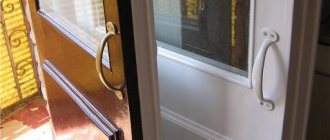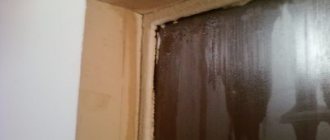How and with what to remove tape from wooden and metal doors?
This is a fairly pressing issue, since dust sticks to the glue and dark spots appear.
Ways to remove tape stains:
- Vegetable oil. It is necessary to saturate the fabric with it and leave for several hours. After this, the doors are washed with warm water.
- Hair dryer. It is necessary to heat the remaining glue with hot air and wipe it with a napkin.
- Eraser. Oddly enough, you can remove the tape using a regular eraser that wipes away the pencil.
How and with what to remove tape from wooden and metal doors?
How to wash walls without streaks
You need to start cleaning any surfaces by checking the safety of the detergent composition.
To do this, pick it up on a sponge or rag and wipe the inconspicuous fragment. Based on how the paint behaves, it is determined whether the drug is suitable or not. If the painted layer has not deteriorated, you can wash the entire surface. Prepare a soft sponge for cleaning. In addition, you will need a well-absorbing fabric or rag for wiping dry. Two buckets are being prepared. In one, the cleaning solution is diluted. Most often, any soap is dissolved in water for this. Another universal solution is table white vinegar. It is added at the rate of a glass per bucket. The second container is left empty for now.
The laundering process starts from the bottom. The sponge is soaked in detergent and wrung out to remove excess moisture. Apply it to the surface from bottom to top. All drips that appear are wiped off immediately. If they dry out, it will be difficult to remove them. The contaminated washcloth is squeezed out over an empty bucket, completely removing the dirty liquid from it. Then the actions are repeated.
The washed painted base needs to be rinsed. At the same time, there is no need to pour water on it, especially if there is a layer of water-based emulsion on it. Therefore, clean water is collected into the container. A thoroughly washed sponge is moistened in it, squeezed out, and the base is treated. Any leaks are removed immediately. Finally, use a dry cloth to carefully wipe the base dry again. You can't leave it wet, it can ruin the paint.
Preparing the surface for washing
It is necessary to carry out wet cleaning of walls as they become dirty, but at least twice a year. Experienced housewives advise doing this in spring and autumn. For the first time after a long winter, when the heating was on and air currents carried dust throughout the house. The second was after the summer, when dust and dirt particles got in from the street through open windows.
Before you start washing, you need to make sure that the wet coating can dry quickly. That is, the house is warm enough and there is no excessive humidity. Otherwise, the result can be unpleasant stains, dampness and even mold. Before washing painted walls, preparatory work is carried out.
Preparing the workspace
We remove all photographs, posters and paintings hanging on the walls. We do the same with any other decor. We mark the released hooks and nails so as not to injure our hands on them. To do this, we attach small pieces of bright fabric to them. We move the furniture to the center of the room so that it does not interfere with free movement.
Protecting the floor from moisture
We lay film or thick fabric along the baseboards. It will protect the floor covering from the unwanted effects of dirty water. If necessary, protect furniture in the same way by covering it with film.
Removing dust from the coating
We carry out dry cleaning, completely removing dust from ceiling skirting boards and walls. The easiest way to do this is with a vacuum cleaner turned on at medium or low power. The floor brush must be removed and a small attachment with a flat base installed. You can use a mop with a clean cloth on it.
Types of coatings
Solid wood makes very durable door leaves, but at the same time quite expensive. Moreover, they require special care. Most doors consist of a wooden frame covered with chipboard or MDF sheets. One of the following coatings is applied on top:
- Lamination. The wooden frame is covered with textured paper impregnated with synthetic resins. Moisture-resistant, tolerates temperature changes well, and is resistant to mechanical damage.
- Veneering. A thin layer of real wood is applied to the frame, treated with a moisture-resistant compound and secured with varnish. Does not tolerate temperature differences and high humidity.
- PVC coating. Polyvinyl chloride is a plastic film coating. These doors are not afraid of moisture and scratches.
- Coloring. Applying paint to the canvas in several layers. Polyurethane or polypropylene enamel will protect the door on any basis and is resistant to moisture.
- Toning. Filling the pores of wood with one or several layers of varnish, possibly using dye.
Standard door cleaning scheme
Regardless of which detergent was chosen for cleaning interior or entrance doors made of wood, the procedure is standard. To wash off small stains, you should perform some procedures in a certain sequence:
- Wipe the door leaf and door with a damp cloth.
- Apply the selected cleaning product to the entire wood surface.
- Rub the areas with difficult stains a little harder with a soft sponge.
- Leave the product on the doors for literally 5 minutes.
- Remove the foam with a damp cloth and remove any remaining moisture with a paper towel or microfiber cloth.
These simple steps will help clean dirt and grease stains from interior doors in just 10 minutes.
Further care
Constantly cleaning entrance or interior wooden doors can damage the protective layer. Even regular use of gentle detergents is fraught with the appearance of scratches and chips, because wood is a capricious material. At least once a week, the housewife will have to use radical methods to care for wood products.
The most popular means include:
- A polish that perfectly fights not only dirt, but also small scratches. This product is intended for caring for wooden surfaces, removing dirt and greasy stains.
- Wax pencils are an excellent tool for restoring damaged wood. For these purposes, you can also use ordinary wax, which copes well with scratches, cracks and chips. Of course, it is better to use such products only for doors that are not varnished, since their use has a certain sequence. First you need to sand the damaged areas with fine-grained sandpaper. After this, wax or a pencil is rubbed into the crack, scratch, or chip. The last stage of restoration is to grout this area with a piece of soft cloth.
The use of wax is a step that often precedes the coating of a wooden door with varnish. Thanks to the soft texture and transparency of the product, you can smooth out damaged areas and preserve the natural color of the wood.
Varnishing a wooden surface
After the natural wood door has been polished and leveled with a wax pencil, you can begin to coat the surface with paints and varnishes. Instead of wax, you can also use nitro varnish in the form of a spray, which has the same effect, but dries in literally 5 minutes.
The advantage of varnish coating is the ability to preserve the original appearance of the product. The transparent product allows you to preserve the natural grain of the wood and create a reliable protective film. Interior doors should be updated in this way as needed (after deep scratches or cracks appear).
Wax pencils and polish for bare wood and MDF
Scratches and other damage can be repaired on wooden surfaces with wax and polish. Polishes are substances that can add shine to the surface being treated. They are presented as paste-like mixtures or emulsions that have a long shelf life.
To remove a scratch in wood, sand the damaged area with a fine abrasive, then apply soft polishing wax and rub with a cloth. A soft wax pencil is used to treat deep scratches. Pencils have a wide color palette, which allows you to choose the desired tone. After repairing the damage, remove any remaining wax with a dry cloth. The surface is coated with varnish or paint to match the door.
When working with MDF profiles, wax pencils are simply irreplaceable when you need to cover the gap at the joints of the profile.
Pros of using wood correctors:
- Operational restoration
- Variety of color palette
- Versatility
- Durability due to increased material adhesion and water resistance.
Tip 4: Features of caring for light veneer
Light door blocks are a universal solution for any interior; in the Porta Prima factory catalog they are presented in a variety of shades and textures. Light-colored veneer is also convenient because dust and micro-scratches are invisible on its surface. However, this does not mean that light-colored door structures do not require maintenance. They should be regularly wiped clean from dust and dirt.
To maintain light-colored finishes, you can make your own polish by mixing three teaspoons of melted granulated wax and 150 ml of soybean oil. The components are mixed until a homogeneous mass is formed and cooled to room temperature. To clean light-colored veneer doors, apply the compound with a dry cloth and rub the coating until shiny and smooth. This mixture is great for removing stubborn dirt and greasy marks around door handles.
Basic moments
Interior doors, no less than other objects in the apartment, accumulate dirt and dust. This is especially noticeable if the door leaf is not monolithic, but has various carved parts and glass. Traces of dirty hands immediately appear on light-colored doors, and the fittings become covered with a sticky layer of dirt mixed with dust.
Eco-veneer is especially vulnerable to contamination, because by and large, it is just a textured film with which the canvas is covered. Film for eco-veneer is produced in different countries; fairly high-quality material is obtained from Koreans, Japanese, and Italians.
In order for the door to please us with its cleanliness and be pleasant to touch, we will have to take care of it during operation. In addition, blank canvases are not so popular now, because the door is most often an integral attribute of the overall picture of the interior of the room, therefore it must be colorful and beautiful, and therefore clean.
Doors support the interior of the room
Let's highlight the main points in caring for doors:
- It is necessary to devote time not only to washing the door leaf itself, but also to cleaning and adjusting the fittings. If it is loose, you need to tighten it, if it creaks, you need to lubricate it.
- If you have doors made of natural wood or solid wood in your home, it is worth adjusting the microclimate in the room. It is undesirable to allow the temperature to rise above 25°C and the humidity to exceed 70%.
- It will not be possible to hide severe damage to high-quality doors; there is no way to hide scratches or dents, so try to treat the material with care.
- If soiled and stained, try to wash your interior doors immediately; it is better not to wait for the dirt to be absorbed into the structure of the material.
- Old doors that are not of the best quality, or modern eco-veneer, can be additionally protected from dirt by coating them with varnish. Not the smartest solution, but accessible to everyone.
- During repairs, cover the doors with plastic, like other pieces of furniture, to avoid getting dirty.
Doors are made from different materials: PVC, laminated, eco-veneer, natural veneer, solid wood. Ideally, each material has its own detergent composition, or just clean water. To properly wash and clean fabrics, you can use the following tips:
When cleaning, pay attention to door hardware
- Many modern doors are equipped with glass; to wash them without smudges and streaks, add a couple of drops of ammonia to the water, provided that they are not frosted.
- Metal parts on the doors can be easily washed with ordinary soapy water.
- To avoid damaging the door covering, it is best to wash and wipe the surface with a soft cloth, such as suede or microfiber.
- Dust will certainly accumulate on decorative inserts and carved elements of doors, so do not forget to remove it during weekly cleaning of the house.
- When finishing washing the door leaf, pay attention to the fittings, wash and disinfect the handles.
Most often, the door fails or loses its aesthetically attractive appearance through our fault, due to poor handling and lack of proper care. But we want the door to serve us faithfully for a long time, so we choose the appropriate product and wash it.
Folk remedies for cleaning MDF doors
Soap solution is the most common folk remedy for washing interior doors.
Many types of stains can be removed using home methods. They are unlikely to remove stubborn and old dirt, but they can easily clean fresh marks.
Soap solution
This is a classic door cleaner. For preparation, use shavings of 72% soap diluted with liquid. All stains are thoroughly treated with it, after which they are washed with plenty of clean water so that no soap traces remain, and wiped with a towel.
To treat doors with a matte texture, it is recommended to add starch to cool water at a rate of 2 tsp. for 500 ml.
Starch or talc
Potatoes and baby powder will also work. The vegetable is cut into two parts and the dirty marks are thoroughly rubbed. When all the spots are covered with potato juice, they are left in this form for 10 minutes until white starch forms. It is wiped with a clean towel or napkin.
If white marks remain on the surface, apply a little baby powder or talcum powder to a rag and carefully wipe off the stains.
Dishwashing liquid
Apply to greasy stains, leave for a few minutes, then rinse off.
Onion juice
One onion is grated on a fine grater and the juice is squeezed out of it. It is used to treat all dirty areas and after a while wipe with a damp cloth and a dry towel.
Baking powder
Take 5 tbsp. l. product and pour warm water to form a thick paste. The resulting product is applied to dirty areas and left for a quarter of an hour. Wash off and wipe.
Vinegar, citric acid
Vinegar, baking soda and citric acid work well to remove greasy stains on doors.
Prepare a weakly concentrated solution of acid and water in a ratio of 1:10, treat all surfaces, rinse off, then wipe dry with a clean cloth.
You can use alcohol instead of vinegar or acid. Soak a napkin in the finished product and carefully apply it to the stain, wait for 3 minutes and rinse off. For convenience, the solution can be poured into a container with a spray bottle and sprayed. This method is suitable for medium levels of contamination.
Acid is an aggressive substance. It is not worth keeping it on the surface of the doors for more than 5 minutes, since with prolonged contact with the protective layer it can damage it.
When caring for a wooden door, after removing various stains, you need to thoroughly dry the contaminated areas with a hairdryer. This is more reliable than using a dry cloth.
Baking soda
You can wash a door made of MDF from greasy stains with soda. This option is suitable if a varnish coating has been applied to the wooden surface. It creates additional protection and gives a beautiful shine. Therefore, this door needs to be looked after so as not to disturb the top layer.
To prepare the solution, mix 1 liter of warm water, 1 tbsp. l. baking soda and washing powder, adding 3 tbsp. l. vinegar. A clean napkin is moistened in the resulting product and the contaminated areas are treated. After this, wipe with a dry towel.
Soda solution is effective against greasy stains, but you need to make sure that the grains of powder are completely dissolved, otherwise they will scratch the surface.
Features of cleaning different types of paint
Different compositions are chosen for painting, therefore, their care is also different. You need to know exactly what product was used to paint the surface, so as not to spoil it during the washing process. Let's look at the most popular formulations
Water-based paint
Coloring pigments are dissolved in a water base, so the finish is very sensitive to moisture. It is best to limit yourself to dry cleaning, as there is a danger of ruining the paint layer. If this is not possible, carefully follow the recommendations on how to wash walls painted with water-based paint. For processing, use only a soft sponge; intense rubbing is prohibited.
Remove oil-based and water-based paint from metal and wooden doors?
To remove oil paint you will have to use a solvent. Vegetable oil, white alcohol or kerosene cope well with stains. Saturate a cloth with one of these liquids and wipe the doors. If it is a water-based emulsion, then you can remove the remaining paint using warm soapy water with the addition of ammonia.
Remove oil-based and water-based paint from metal and wooden doors?
No matter how scary the stains may seem, they can almost always be washed off if you know a few tricks.
How and with what to remove grease stains and dirt from a metal door without streaks: products, recipes, tips
It’s quite easy to wash everything off a metal door. You can use abrasives, but there is a risk of scratches.
Stain removers:
- Mister Muscle. You need to purchase a universal product. It is applied with a spray and removed with a cloth.
- Dishwashing liquid. Just dampen the sponge and apply a little product. Scrub the door and remove the foam with a damp cloth.
- Silit. The same product is sold in a spray bottle. Apply to the doors and simply wipe with a cloth.
How and with what to remove grease stains and dirt from a metal door without streaks: products, recipes, tips
Glass door
Glass is one of the most solvent-resistant materials, so grease can be washed off with a variety of substances.
Various alcohols and alcohol-containing liquids are especially effective (this applies to strong alcohol, antiseptics and special products for cleaning glass and tiles). A solution of ammonia and water in a ratio of 1:10 will cope with fresh stains. Additionally, you can use vinegar, medical alcohol, soda or citric acid. Acetone or any paint thinner can cope with older and more durable stains.
In addition to the smooth glass surface, glass sheets with protrusions and a rough surface are used to make doors, where fat easily gets clogged and cools.
In such cases, it is necessary to wet the glass more abundantly so that the solvent penetrates as deeply as possible into hard-to-reach places and breaks down the fat.
Dissolved fat must be wiped off with a soft, clean cloth. To avoid streaks, the glass is washed with an alcohol-containing window cleaner and wiped dry.
How to renew a varnished door: how to clean, wash doors
External door defects do not always require its replacement; more often, owners resort to restoration of defects.
Special compounds sold in stores will help disguise scratches, chips and abrasions that so often appear on the varnish coating. In addition to such damage, the door can be contaminated with such compounds, which must be wiped off competently and carefully. In this article we will analyze all the damage and how to fix it.
Working with glass
If frosted or regular glass is inserted into the door, you should start washing the door with it, and only then move directly to the canvas. Smooth glass can be washed with ordinary soft rags with a minimum amount of lint; frosted glass can be rubbed with a brush with soft bristles.
Frosted glass is produced using the sandblasting method. The top layer is knocked off a smooth surface using sand, causing the glass to take on a cloudy appearance with a frosty effect. Frosted glass allows you to hide what is happening behind the door starting from a distance of 30-40 centimeters.
Frosted glass can be easily washed off grease stains and fingerprints using dishwashing liquid or starch solution. To prepare the solution, add starch to warm water, 3-4 teaspoons per 1 liter.
Veneered doors: 8 useful maintenance tips
Interior doors coated with natural and artificial veneer are consistently among the top sales. This is not surprising - veneered door leaves look beautiful, are affordable, reliable and durable. Such designs can fit into any interior design solution thanks to a wide selection of shades and veneer textures - from almost white ash to chocolate brown wenge. And externally, veneered panels look exactly like natural wood.
Caring for veneered doors is not particularly difficult. You just need to regularly remove dust and dirt, and also monitor the serviceability of the door hardware. However, there are a number of rules that must be followed in order for door blocks to maintain their aesthetic appearance and functionality for a long time.











